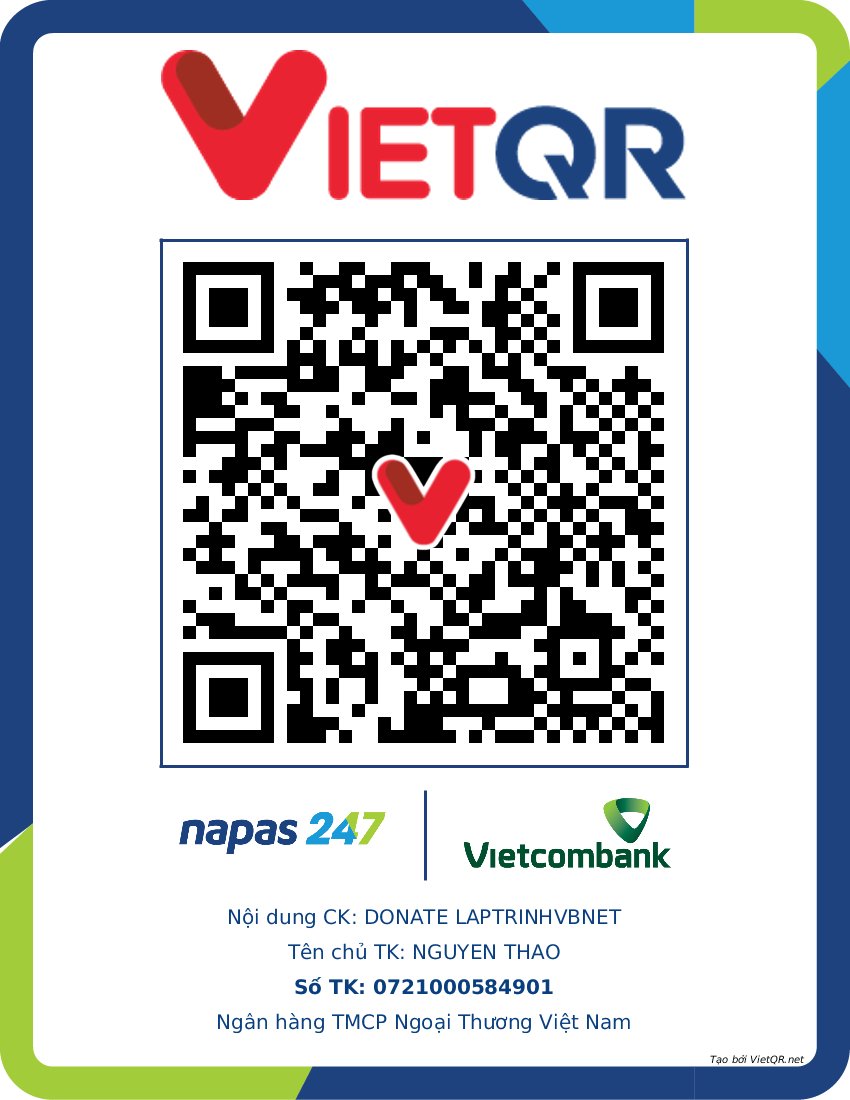- KHI SỰ TINH GIẢN LÀ ĐỈNH CAO CỦA CÔNG NGHỆ BÁN HÀNG 2026 - PHẦN MỀM BÁN HÀNG BASYS
- Phần mềm bán hàng cho hộ kinh doanh BASYS đơn giản ít thao tác
- [C#] Hướng dẫn tích hợp thêm menu vào System menu của ứng dụng
- [DEVEXPRESS] Hỗ trợ tìm kiếm highlight không dấu và không khoảng cách trên Gridview Filter
- [C#] Chia sẻ source code phần mềm Image Downloader tải hàng loạt hình ảnh từ danh sách link url
- [C#] Chụp hình và quay video từ camera trên winform
- [C#] Chia sẽ full source code tách file Pdf thành nhiều file với các tùy chọn
- Giới thiệu về Stock Tracker Widget - Công cụ theo dõi cổ phiếu và cảnh báo giá tăng giảm bằng C# và WPF
- [VB.NET] Chia sẻ công cụ nhập số tiền tự động định dạng tiền tệ Việt Nam
- [VB.NET] Hướng dẫn fill dữ liệu từ winform vào Microsoft word
- [VB.NET] Hướng dẫn chọn nhiều dòng trên Datagridview
- Hướng Dẫn Đăng Nhập Nhiều Tài Khoản Zalo Trên Máy Tính Cực Kỳ Đơn Giản
- [C#] Chia sẻ source code phần mềm đếm số trang tập tin file PDF
- [C#] Cách Sử Dụng DeviceId trong C# Để Tạo Khóa Cho Ứng Dụng
- [SQLSERVER] Loại bỏ Restricted User trên database MSSQL
- [C#] Hướng dẫn tạo mã QRcode Style trên winform
- [C#] Hướng dẫn sử dụng temp mail service api trên winform
- [C#] Hướng dẫn tạo mã thanh toán VietQR Pay không sử dụng API trên winform
- [C#] Hướng Dẫn Tạo Windows Service Đơn Giản Bằng Topshelf
- [C#] Chia sẻ source code đọc dữ liệu từ Google Sheet trên winform
[C#] Hướng dẫn tạo Overlay Modal Dialog Winform
Xin chào các bạn, bài viết hôm nay mình sẽ hướng dẫn các bạn cách overlay background, khi show dialog winform c# giống Modal trên Website.
Thường các bạn thấy các hộp thoại Modal trên website, khi show dialoag thì sẽ có một background overlay màu đen bao quanh Dialog.
Dưới đây là giao diện Overlay Modal Dialog khi show winform
.jpg)
Bươc 1: Các bạn tạo một class MaskedDialog.cs với source code C# bên dưới
using System;
using System.Collections.Generic;
using System.Linq;
using System.Text;
using System.Threading.Tasks;
using System.Windows.Forms;
namespace Modal_Dialog
{
class MaskedDialog : Form
{
static MaskedDialog mask;
static Form frmContainer;
private Form dialog;
private UserControl ucDialog;
private MaskedDialog(Form parent, Form dialog)
{
this.dialog = dialog;
this.FormBorderStyle = FormBorderStyle.None;
this.BackColor = System.Drawing.Color.Black;
this.Opacity = 0.50;
this.ShowInTaskbar = false;
this.StartPosition = FormStartPosition.Manual;
this.Size = parent.ClientSize;
this.Location = parent.PointToScreen(System.Drawing.Point.Empty);
parent.Move += AdjustPosition;
parent.SizeChanged += AdjustPosition;
}
private MaskedDialog(Form parent, UserControl ucDialog)
{
this.ucDialog = ucDialog;
this.FormBorderStyle = FormBorderStyle.None;
this.BackColor = System.Drawing.Color.Black;
this.Opacity = 0.50;
this.ShowInTaskbar = false;
this.StartPosition = FormStartPosition.Manual;
this.Size = parent.ClientSize;
this.Location = parent.PointToScreen(System.Drawing.Point.Empty);
parent.Move += AdjustPosition;
parent.SizeChanged += AdjustPosition;
}
private void AdjustPosition(object sender, EventArgs e)
{
Form parent = sender as Form;
this.Location = parent.PointToScreen(System.Drawing.Point.Empty);
this.ClientSize = parent.ClientSize;
}
//
public static DialogResult ShowDialog(Form parent, Form dialog)
{
mask = new MaskedDialog(parent, dialog);
dialog.StartPosition = FormStartPosition.CenterParent;
mask.MdiParent = parent.MdiParent;
mask.Show();
DialogResult result = dialog.ShowDialog(mask);
mask.Close();
return result;
}
public static DialogResult ShowDialog(Form parent, UserControl dialog)
{
mask = new MaskedDialog(parent, dialog);
frmContainer = new Form();
frmContainer.ShowInTaskbar = false;
frmContainer.FormBorderStyle = System.Windows.Forms.FormBorderStyle.None;
frmContainer.StartPosition = FormStartPosition.CenterScreen;
frmContainer.Height = dialog.Height;
frmContainer.Width = dialog.Width;
frmContainer.Controls.Add(dialog);
mask.MdiParent = parent.MdiParent;
mask.Show();
DialogResult result = frmContainer.ShowDialog(mask);
frmContainer.Close();
mask.Close();
return result;
}
public static void CloseDialog()
{
if (frmContainer != null)
{
frmContainer.Close();
}
}
private void InitializeComponent()
{
this.SuspendLayout();
//
// MaskedDialog
//
this.ClientSize = new System.Drawing.Size(783, 490);
this.Name = "MaskedDialog";
this.FormClosing += new System.Windows.Forms.FormClosingEventHandler(this.MaskedDialog_FormClosing);
this.Load += new System.EventHandler(this.MaskedDialog_Load);
this.ResumeLayout(false);
}
private void MaskedDialog_Load(object sender, EventArgs e)
{
}
private void MaskedDialog_FormClosing(object sender, FormClosingEventArgs e)
{
}
private void button1_Click(object sender, EventArgs e)
{
}
}
}Bước 2: Viết sự kiện cho nút show Form
private void button1_Click(object sender, EventArgs e)
{
var f2 = new Form2();
MaskedDialog.ShowDialog(this, f2);
f2.Dispose();
f2 = null;
}HAPPY CODING ![]()


